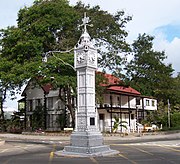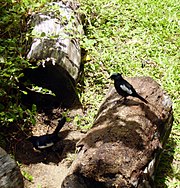Seychelles
From Wikipedia, the free encyclopedia.
The Republic of Seychelles (say-SHELLS or say-SHELL) (Creole: Repiblik Sesel) is a nation of islands in the Indian Ocean, some 1,600 km east of mainland Africa, northeast of the island of Madagascar. Other nearby island countries and territories include Mauritius and Réunion to the south, Comoros and Mayotte to the southwest, and the Maldives to the northeast.
|
|||||
| National motto: Finis Coronat Opus (Latin: The End Crowns the Work) |
|||||
 |
|||||
| Official languages | Creole; English and French | ||||
| Capital | Victoria | ||||
| President | James Michel | ||||
| Area - Total - % water |
Ranked 177th 455 km² Negligible |
||||
| Population - Total (year) - Density |
Ranked 181st 81,188 (2005 est.) 178/km² |
||||
| Independence - Date |
From the United Kingdom June 29, 1976 |
||||
| Currency | Seychelles rupee | ||||
| Time zone | UTC +4 | ||||
| National anthem | Koste Seselwa | ||||
| Internet TLD | .sc | ||||
| Calling Code | 248 | ||||
Contents |
History
Main article: History of Seychelles
While Arab traders were probably the first to visit the uninhabited Seychelles, the first recorded sighting of them took place in 1505, by the Portuguese. As a transit point for trading between Africa and Asia, they were occasionally used by pirates until the French began to take control of the islands starting in 1756, naming them after Jean Moreau de Sechelles, the then French finance minister.
The British contested control over the islands with the French between 1794 and 1811, with the British eventually gaining the upper hand and being ceded the islands in 1814. The Seychelles became a crown colony separate from Mauritius in 1903 and independence was granted in 1976, as a republic within the Commonwealth. The 1979 constitution declared a socialist one-party state, which lasted until 1992.
Politics
Main article: Politics of Seychelles
The Seychellois president, who is both head of state and head of government, is elected by popular vote for a five-year term of office. The previous president, France-Albert René, was democratically elected after the constitutional reforms of 1992, though he had been in power since a coup d'état in 1977. He stood down in 2004 in favour of his vice-president, James Michel. The cabinet is presided over and appointed by the president, subject to the approval of a majority of the legislature.
The unicameral Seychellois parliament, the National Assembly or Assemblée Nationale, consists of 34 members, of whom 25 are elected directly by popular vote, while the remaining 9 seats are appointed proportionally according to the percentage of votes received by each party. All members serve five-year terms.
Politics is a topic of hot debate in the country - with many claiming theres a social and economic divide between the two leading parties and their supporters.
The Seychelles are part of the Indian Ocean Commission.
Districts
Main article: Districts of Seychelles
The main island, Mahe, is divided into 23 administrative regions, called districts:
Geography
Main article: Geography of Seychelles
The Seychelles constitute an archipelago in the Indian Ocean of about 115 islands, of which 33 are inhabited. The group of islands around Mahé consist of granite and are the largest and most populated of the country. The remaining outer group consists of smaller coralline atolls. The capital city, Victoria, is situated on Mahé, which is the largest island and home to about 80% of the total population, as well as the Seychelles' highest point, the Morne Seychellois at 905 m.
The local climate is tropical, tempered by marine influences and fairly humid. The southeast monsoon is a generally cooler season which lasts from late May to September, while the warmer northwest monsoon lasts from March to May. The Seychelles are fortunate to lie outside the tropical cyclone belt.
Seychelles largely escaped the Asian Tsunami of December 2004 spawned by an earthquake. However, the islands did see significant flooding and damage - as well as large loss of marine life and deathtoll of three persons.
Economy
Main article: Economy of Seychelles
Since independence in 1976, per capita output has expanded to roughly seven times the old near-subsistence level. Growth has been led by the tourist sector, which employs about 30% of the labour force and provides more than 70% of hard currency earnings, and by tuna fishing. In recent years the government has encouraged foreign investment in order to upgrade hotels and other services.
At the same time, the government has moved to reduce the dependence on tourism by promoting the development of farming, fishing, and small-scale manufacturing. The vulnerability of the tourist sector was illustrated by the sharp drop in 1991-1992 due largely to the country's significantly overvalued exchange rate, the Gulf War and once again following the September 11, 2001 attacks on the U.S.. Other issues facing the government are the curbing of the budget deficit, including the containment of social welfare costs, and further privatisation of public enterprises. The government has a pervasive presence in economic activity, with public enterprises active in petroleum product distribution, insurance, banking, imports of basic products, telecommunications, and a wide range of other businesses.
Growth slowed in 1998–2001, due to sluggish tourist and tuna sectors. Also, tight controls on exchange rates and the scarcity of foreign exchange have impaired short-term economic prospects. The black market value of the Seychelles rupee is half the official exchange rate; without a devaluation of the currency the tourist sector should remain sluggish as tourists seek cheaper destinations such as nearby Comoros and Madagascar.
At official exchange rates Seychelles remains the richest country in Africa in terms of GDP per capita. (US$7,504 as of 2005), although if the parallel exchange rate, or purchasing power parity rates, are used, it ranks behind Mauritius and Botswana. Because of economic contraction (the economy declined by about 2% in 2004 and is set to decline by at least the same level in 2005) the country is moving downwards in terms of per capita income.
It is important to note that Seychelles is the most highly indebted country in the world, with total public debt around 200% of GDP. Approximately two thirds of this debt is owed domestically, with the balance due to multilaterals, bilaterals and commercial banks. The country is in arrears to most of its international creditors and has had to resort to pledged commercial debt to continue to be able to borrow. This high debt burden is a direct consequence of the overvalued exchange rate — in essence, the country is living beyond its means, and financing its lifestyle by borrowing domestically and internationally.
Demographics
Main article: Demographics of Seychelles
As the islands of the Seychelles had no indigenous population, the current Seychellois are composed of immigrants, mostly of French, African, Indian, and Chinese descent. French and English are official languages along with a French-based Creole. Most Seychellois are Christians, mostly Catholics.
Culture
Main article: Culture of Seychelles
Fauna and flora
The islands are home to 81 endemic plant species. Well-known is the Coco de mer, a species of palm that grows only on the islands of Praslin and Curieuse. Sometimes nicknamed the 'love nut' because of its suggestive shape, the coco-de-mer is the world's largest seed.
Miscellaneous topics
- List of Notable Seychellois
- Communications in Seychelles
- Transportation in Seychelles
- Military of Seychelles
- Foreign relations of Seychelles
Further reading
- Birds of the Seychelles Ian Bullock, Adrian Skerrett, Tony Disley
- Bradt travel Guide: Seychelles Lynnath Beckleya and Lyn Mair
- The History of Slavery in Mauritius and the Seychelles, 1810-1875 Moses D. E., Nwulia
- Insight Guide: Mauritius, Réunion and Seychelles Emily Hatchwell
- Insight Pocket Guide: Seychelles Judith Skerrett
- Lonely Planet World Guide: Mauritius, Réunion and Seychelles Jan Dodd, Madeleine Philippe
- Political Castaways Christopher Lee
- The Seychelles Michael Friedel
- Seychelles Vincenzo Paolillo
- Seychelles: Garden of Eden in the Indian Ocean Sarah Carpin
- Seychelles: The New Era France René
- Seychelles Since 1770: History of a Slave and Post-Slavery Society Deryck Scarr
'Rivals in Eden'and 'Hard Times in Paradise' Bill McAteer
External links
Government
- Virtual Seychelles official portal of the Republic of Seychelles
Overviews
- BBC News Country Profile - Seychelles
- CIA World Factbook - Seychelles
- Library of Congress Country Study - Seychelles data as of August 1994
Directories
- LookSmart - Seychelles directory category
- Open Directory Project - Seychelles directory category
- Stanford University - Africa South of the Sahara: Seychelles directory category
- The Index on Africa - Seychelles directory category
- University of Pennsylvania - African Studies Center: Seychelles directory category
- Yahoo! - Seychelles directory category
Tourism
Other
- Seychelles Nation Online
- Seychelles Magic (travel)
- Seychelles Photos
- Aerial videos etc.
- Seychelles Pictures
- EWLA! Free Seychelles Classified Ads (online shopping)
- Seychelles Surfing Photo Gallery
| Countries in Africa | ||
|
Algeria | Angola | Benin | Botswana | Burkina Faso | Burundi | Cameroon | Cape Verde | Central African Republic | Chad | Comoros | Democratic Republic of the Congo | Republic of the Congo | Côte d'Ivoire | Djibouti | Egypt | Equatorial Guinea | Eritrea | Ethiopia | Gabon | The Gambia | Ghana | Guinea | Guinea-Bissau | Kenya | Lesotho | Liberia | Libya | Madagascar | Malawi | Mali | Mauritania | Mauritius | Morocco | Mozambique | Namibia | Niger | Nigeria | Rwanda | São Tomé and Príncipe | Senegal | Seychelles | Sierra Leone | Somalia/Somaliland | South Africa | Sudan | Swaziland | Tanzania | Togo | Tunisia | Uganda | Western Sahara/SADR | Zambia | Zimbabwe |
||
| Dependencies: British Indian Ocean Territory | Canary Islands | Ceuta and Melilla | Madeira Islands | Mayotte | Réunion | Saint Helena and dependencies | ||






.jpg/180px-Victoria_(Seychelles).jpg)





